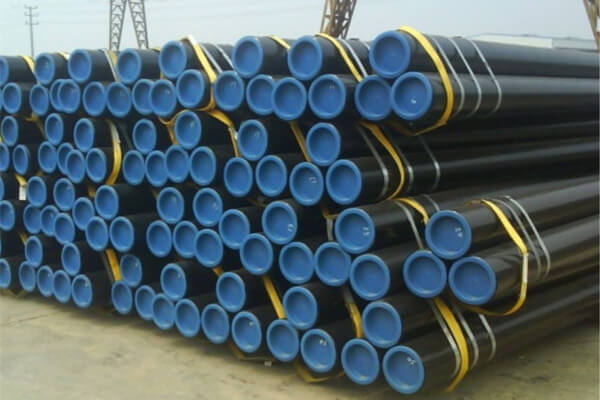
Schedule 40 Steel Pipes
Talk To Us – We’re Here To Help
ANSI/ ASME B36.10 Schedule 40 Carbon Steel Pipe chart, dimensions, weight, Supplier and exporter of SCH 40 Pipe in API 5L, Schedule 40 Pipe Wall Thickness, Alloy & Carbon Steel SCH 40 Pipe Size Chart as per ASME B36.10, ASTM A106/A53 Grade B, A333 Gr 6, A335 P22/ P11/ P9 material in India.
Steel pipes come in various grades and schedules, defining their thickness and strength. The Schedule 40 (Sch 40) pipe is one such standard, offering a range of uses and benefits. For Schedule 40 pipes, the standard wall thickness is 4 mm, referred to as the Sch 40 pipe thickness (in mm).
Coating and Thickness Schedule 40 pipes can be coated with zinc through in-line galvanization or hot-dip galvanization. Hot-dip galvanization involves dipping the pipe into molten zinc, creating a strong bond that enhances corrosion resistance. The “Sch 40” designation indicates that the pipe can handle pressures up to 40 kg, with a schedule 40 pipe thickness in mm of 4 mm.
Materials and Grades Schedule 40 pipes are available in different materials and grades, including stainless steel, carbon steel, and aluminum. Stainless Steel Schedule 40 pipes, like SS 304 and SS 316L, are resistant to corrosion, particularly from chloride ions. These pipes are also easier to weld due to their lower carbon content.
Applications and Sizes Sch 40 pipes are used for various purposes, including air, oil, water, and natural gas transport. They are generally suited for applications with lower pressure due to their thinner walls. For instance, smaller lines might use 1-inch Schedule 40 Stainless Steel Pipes. The weight of these pipes varies with diameter; typically, Sch 40 pipes weigh around 1.68 lbs per foot.
Pipe Thickness and Classification To determine Sch 40 pipe thickness in mm, refer to the ANSI B36.10 standards, which include multiple schedules such as Sch10, Sch20, Sch30, Sch40, and more. Despite the transition from old classifications like Standard Weight (STD), Double Extra Strong (XXS), and Extra Strong (XS), these terms are still commonly used.
Manufacturers and Suppliers We are leading manufacturers and suppliers of Schedule 40 pipes in various materials, including Stainless Steel, ASTM A106 Grade B, A53 Gr B, A333 Grade 6, API 5L Grade B Carbon Steel, and galvanized materials. For reliable Schedule 40 Carbon Steel Pipe, you can count on our extensive inventory and expertise.
What is the Schedule 40 Pipe?
Schedule 40 pipe is a type of pipe with a specific wall thickness that allows it to handle a pressure of 40 kg. The standard thickness for a Schedule 40 pipe is around 4 mm. This type of pipe is one of the most common and versatile, often used in various applications, including water and gas lines. While it can be galvanized for added protection, it doesn’t necessarily have to be.
Schedule 40 pipes are also popular in structural and decorative uses due to their durability and wide range of applications. They are available in different materials such as stainless steel, carbon steel, and aluminum, and come in various grades like ASTM A106 Grade B, A53 Grade B, and API 5L Grade B.
The wall thickness of pipes is categorized by different schedules, ranging from Sch10 to Sch160, with Schedule 40 being one of the most widely used due to its balance of strength and versatility. Manufacturers and suppliers offer Schedule 40 pipes in various materials to meet different industry needs.
Chemical Composition of Schedule 40 Steel Pipe
Schedule 40 steel pipe is a widely used pipe with a standard thickness, suitable for various applications. Its chemical composition can vary depending on the grade and type of steel, but generally includes the following elements:
Carbon (C):
Carbon is the primary element in steel, influencing its strength, hardness, ductility, toughness, and weldability. It’s typically present in amounts ranging from 0.05% to 1.5%.’
Manganese (Mn):
Manganese is added to steel to enhance its strength, toughness, and hardenability. It usually ranges from 0.3% to 1.5%.
Phosphorus (P):
Phosphorus is present in small amounts, typically from 0.04% to 0.12%. It can affect the steel’s properties, depending on the application.
Sulfur (S):
Sulfur, found in amounts ranging from 0.05% to 0.30%, can have both beneficial and detrimental effects on steel, influencing machinability and toughness.
Silicon (Si):
Silicon is added to steel to improve its strength, hardness, and ductility, it’s typically present in amounts from 0.15% to 0.40%.
Copper (Cu):
Copper enhances corrosion resistance in steel and is usually present in small amounts, ranging from 0.20% to 0.40%.
Chromium (Cr):
Chromium increases corrosion resistance, hardness, and strength, typically in amounts from 0.08% to 0.40%.
Nickel (Ni):
Nickel improves corrosion resistance, strength, and toughness, generally present in amounts from 0.25% to 0.45%.
The exact chemical composition of a Schedule 40 steel pipe may vary depending on the specific grade, type of steel, and additional alloying elements. For precise details, it is essential to refer to the manufacturer’s specifications.
Grades of Schedule 40 Steel Pipe
Schedule 40 steel pipe comes in various grades, each tailored for specific applications based on its properties and characteristics. The most common grades include:
- ASTM A53 Grade B:
This is the most widely used grade of Schedule 40 steel pipe. It’s versatile and suitable for applications like plumbing, construction, and industrial uses. It offers a minimum yield strength of 35,000 psi and a minimum tensile strength of 60,000 psi. - ASTM A106 Grade B:
Ideal for high-temperature environments, such as steam and gas lines, as well as refineries and plants. It shares the same minimum yield strength of 35,000 psi and tensile strength of 60,000 psi as ASTM A53 Grade B. - API 5L Grade B:
Commonly used in the oil and gas industry, this grade also offers a minimum yield strength of 35,000 psi and a minimum tensile strength of 60,000 psi, making it reliable for transporting oil and natural gas. - ASTM A333 Grade 6:
Designed for low-temperature service, this grade is often used in cryogenic applications like liquefied natural gas (LNG) plants. It also has a minimum yield strength of 35,000 psi and a minimum tensile strength of 60,000 psi.
Other grades of Schedule 40 steel pipe are available depending on specific needs and applications. Always refer to the manufacturer’s specifications to select the appropriate grade for your project.
Applications of Schedule 40 Steel Pipe
Schedule 40 steel pipe is highly versatile and is widely used across various industries due to its durability and reliability. Here are some of the most common applications:
- Plumbing and HVAC:
Schedule 40 steel pipe is commonly used in plumbing systems for residential, commercial, and industrial buildings. It’s also utilized in heating, ventilation, and air conditioning (HVAC) systems for efficient fluid conveyance. - Water Treatment:
In water treatment plants, Schedule 40 steel pipe is used to transport clean water and wastewater, ensuring safe and effective distribution. - Oil and Gas:
This pipe is frequently employed in the oil and gas industry for transporting crude oil, natural gas, and other petroleum products, thanks to its strength and pressure-handling capabilities. - Chemical Processing:
In chemical processing plants, Schedule 40 steel pipe is ideal for transporting acids, alkalis, and other corrosive chemicals due to its resistance to harsh environments. - Power Generation:
Schedule 40 steel pipe is used in power plants to convey steam and other fluids in high-temperature and high-pressure conditions, supporting the efficient operation of power generation systems. - Construction:
Widely used in construction, Schedule 40 steel pipe serves structural purposes such as building supports, scaffolding, and fencing, providing stability and strength. - Agriculture:
In agricultural settings, Schedule 40 steel pipe is used in irrigation systems to transport water to crops. It’s also used for supporting structures like greenhouses. - Mining:
Schedule 40 steel pipe is utilized in mining operations to convey slurries and other materials, often in corrosive environments where durability is essential.
Overall, Schedule 40 steel pipe is a robust and adaptable material, suitable for a wide array of applications across numerous industries.
SCH 40 Nominal pipe size (NPS)
| NPS | 1/2 | 3/4 | 1 | 1¼ | 1½ | 2 | 2½ | 3 | 3½ | 4 |
| DN | 15 | 20 | 25 | 32 | 40 | 50 | 65 | 80 | 90 | 100 |
Schedule 40 Pipe size chart, dimensions, wall thickness and weight
| Nominal size [inches] | Outside diameter [inches] | Outside diameter [mm] | Wall thickness [inches] | Wall thickness [mm] | Weight [lb/ft] | Weight [kg/m] |
| 1/8 inches | 0.405 inches | 10.3 MM | 0.068 inches | 1.73 MM | 0.24 lb/ft | 0.37 kg/m |
| 1/4 inches | 0.540 inches | 13.7 MM | 0.088 inches | 2.24 MM | 0.42 lb/ft | 0.84 kg/m |
| 1/2 inches | 0.840 inches | 21.3 MM | 0.109 inches | 2.77 MM | 0.85 lb/ft | 1.27 kg/m |
| 3/4 inches | 1.050 inches | 26.7 MM | 0.113 inches | 2.87 MM | 1.13 lb/ft | 1.69 kg/m |
| 1 inches | 1.315 inches | 33.4 MM | 0.133 inches | 3.38 MM | 1.68 lb/ft | 2.50 kg/m |
| 1 1/4 inches | 1.660 inches | 42.2 MM | 0.140 inches | 3.56 MM | 2.27 lb/ft | 3.39 kg/m |
| 1 1/2 inches | 1.900 inches | 48.3 MM | 0.145 inches | 3.68 MM | 2.72 lb/ft | 4.05 kg/m |
| 2 inches | 2.375 inches | 60.3 MM | 0.154 inches | 3.91 MM | 3.65 lb/ft | 5.44 kg/m |
| 2 1/2 inches | 2.875 inches | 73.0 MM | 0.203 inches | 5.16 MM | 5.79 lb/ft | 8.63 kg/m |
| 3 inches | 3.500 inches | 88.9 MM | 0.216 inches | 5.49 MM | 7.58 lb/ft | 11.29 kg/m |
| 3 1/2 inches | 4.000 inches | 101.6 MM | 0.226 inches | 5.74 MM | 9.11 lb/ft | 13.57 kg/m |
| 4 inches | 4.500 inches | 114.3 MM | 0.237 inches | 6.02 MM | 10.79 lb/ft | 16.07 kg/m |
| 5 inches | 5.563 inches | 141.3 MM | 0.258 inches | 6.55 MM | 14.62 lb/ft | 21.77 kg/m |
| 6 inches | 6.625 inches | 168.3 MM | 0.280 inches | 7.11 MM | 18.97 lb/ft | 28.26 kg/m |
| 8 inches | 8.625 inches | 219.1 MM | 0.322 inches | 8.18 MM | 28.55 lb/ft | 42.55 kg/m |
| 10 inches | 10.750 inches | 273.0 MM | 0.365 inches | 9.27 MM | 40.48 lb/ft | 60.31 kg/m |
| 12 inches | 12.750 inches | 323.8 MM | 0.406 inches | 10.31 MM | 53.52 lb/ft | 79.73 kg/m |
| 14 inches | 14 inches | 355.6 MM | 0.375 inches | 11.13 MM | 54.57 lb/ft | 94.55 kg/m |
| 16 inches | 16 inches | 406.4 MM | 0.500 inches | 12.70 MM | 82.77 lb/ft | 123.30 kg/m |
| 18 inches | 18 inches | 457.0 MM | 0.562 inches | 14.27 MM | 104.67 lb/ft | 155.80 kg/m |
| 20 inches | 20 inches | 508.0 MM | 0.594 inches | 15.09 MM | 123.11 lb/ft | 183.42 kg/m |
| 24 inches | 24 inches | 610.0 MM | 0.688 inches | 17.48 MM | 171.29 lb/ft | 255.41 kg/m |
| 32 inches | 32 inches | 813.0 MM | 0.688 inches | 17.48 MM | 230.08 lb/ft | 342.91 kg/m |
Schedule 40 Pipes Pressure Rating
| Maximum Allowable Pressure (psi) (kPa) | ||
|---|---|---|
| NPS | Outside Diameter | Schedule |
| (inch) | (inch) (mm) |
40 |
| 1/4 inch | 0.54 inch 13.7 mm |
7985 55057 |
| 3/8 inch | 0.675 inch 17.1 mm |
6606 45548 |
| 1/2 inch | 0.84 inch 21.3 mm |
6358 43838 |
| 3/4 inch | 1.05 inch 26.7 mm |
5273 36357 |
| 1 inch | 1.315 inch 33.4 mm |
4956 34172 |
| 1 1/4 inch | 1.66 inch 42.2 mm |
4133 28497 |
| 1 1/2 inch | 1.9 inch 48.3 mm |
3739 25780 |
| 2 inch | 2.375 inch 60.3 mm |
3177 21905 |
| 2 1/2 inch | 2.875 inch 73 mm |
3460 23857 |
| 3 inch | 3.5 inch 88.9 mm |
3024 20850 |
| 3 1/2 inch | 4 inch 102 mm |
2769 19092 |
| 4 inch | 4.5 inch 114 mm |
2581 17796 |
| 5 inch | 5.563 inch 141 mm |
2273 15672 |
| 6 inch | 6.625 inch 168 mm |
2071 14280 |
| 8 inch | 8.625 inch 219 mm |
1829 12611 |
| 10 inch | 10.75 inch 273 mm |
1664 11473 |
| 12 inch | 12.75 inch 324 mm |
1560 10756 |
| 14 inch | 14 inch 356 mm |
1533 10570 |
| 16 inch | 16 inch 406 mm |
1531 10556 |
| 18 inch | 18 inch 457 mm |
1530 10549 |
| 20 inch | 20 inch 508 mm |
1455 10032 |
| 22 inch | 22 inch 559 mm |
|
| 24 inch | 24 inch 610 mm |
1405 9687 |
| 30 inch | 30 inch 762 mm |
|
| 32 inch | 32 inch 813 mm |
1054 7267 |
| 34 inch | 34 inch 864 mm |
992 6840 |
| 36 inch | 36 inch 914 mm |
1021 7040 |
| 42 inch | 42 inch 1067 mm |
875 6033 |
Schedule 40 Pipe Dimensions and Wall Thickness
| Pipe Sizes* | O.D. (in.) | Schedule (40) Pipe Wall Thickness (in.)** |
|
| Sch.40 | |||
| Wall (in) | I.D. (in) | ||
| 1/8″ | 0.41 od | 0.07 in | 0.269 id |
| Weight (lbs/ft.) | Steel | 0.247 lbs/ft | |
| Stainless | |||
| Aluminum | |||
| 1/4″ | 0.54 od | 0.090 in | 0.364 id |
| Weight (lbs/ft.) | Steel | 0.429 lbs/ft | |
| Stainless | |||
| Aluminum | 0.147 lbs/ft | ||
| 3/8″ | 0.675 od | 0.091 in | 0.493 id |
| Weight (lbs/ft.) | Steel | 0.570 lbs/ft | |
| Stainless | |||
| Aluminum | 0.196 lbs/ft | ||
| 1/2″ | 0.840 od | 0.109 in | 0.622 id |
| Weight (lbs/ft.) | Steel | 0.850 lbs/ft | |
| Stainless | |||
| Aluminum | 0.294 lbs/ft | ||
| 3/4″ | 1.050 od | 0.113 in | 0.824 id |
| Weight (lbs/ft.) | Steel | 1.13 lbs/ft | |
| Stainless | |||
| Aluminum | 0.391 | ||
| 1″ | 1.315 od | 0.133 in | 1.049 id |
| Weight (lbs/ft.) | Steel | 1.68 lbs/ft | |
| Stainless | |||
| Aluminum | 0.581 lbs/ft | ||
| 1-1/4″ | 1.66 od | 0.140 in | 1.380 id |
| Weight (lbs/ft.) | Steel | 2.27 lbs/ft | |
| Stainless | |||
| Aluminum | 0.785 lbs/ft | ||
| 1-1/2″ | 1.90 od | 0.145 in | 1.610 id |
| Weight (lbs/ft.) | Steel | 2.72 lbs/ft | |
| Stainless | |||
| Aluminum | 0.939 lbs/ft | ||
| 2″ | 2.375 od | 0.154 in | 2.067 id |
| Weight (lbs/ft.) | Steel | 3.66 lbs/ft | |
| Stainless | |||
| Aluminum | 1.260 lbs/ft | ||
| 2-1/2″ | 2.875 od | 0.203 in | 2.469 id |
| Weight (lbs/ft.) | Steel | 5.80 lbs/ft | |
| Stainless | |||
| Aluminum | 2.000 lbs/ft | ||
| 3″ | 3.50 od | 0.216 in | 3.068 id |
| Weight (lbs/ft.) | Steel | 7.58 lbs/ft | |
| Stainless | |||
| Aluminum | 2.620 lbs/ft | ||
| 3-1/2″ | 4.00 od | 0.226 in | 3.550 id |
| Weight (lbs/ft.) | Steel | 9.12 lbs/ft | |
| Stainless | |||
| Aluminum | 3.150 lbs/ft | ||
| 4″ | 4.50 od | 0.237 in | 4.026 id |
| Weight (lbs/ft.) | Steel | 10.80 lbs/ft | |
| Stainless | |||
| Aluminum | 3.730 lbs/ft | ||
| 5″ | 5.563 od | 0.258 in | 5.047 id |
| Weight (lbs/ft.) | Steel | 14.63 lbs/ft | |
| Stainless | |||
| Aluminum | 5.050 lbs/ft | ||
| 6″ | 6.625 od | 0.280 in | 6.065 id |
| Weight (lbs/ft.) | Steel | 18.99 lbs/ft | |
| Stainless | |||
| Aluminum | 6.560 lbs/ft | ||
| 8″ | 8.625 od | 0.322 in | 7.981 id |
| Weight (lbs/ft.) | Steel | 28.58 lbs/ft | |
| Stainless | |||
| Aluminum | 9.88 lbs/ft | ||
| *Nominal sizes apply – Pipe Size is the generic Industry Size Standard for reference only **Tolerances may vary slightly from each manufacturer | |||


